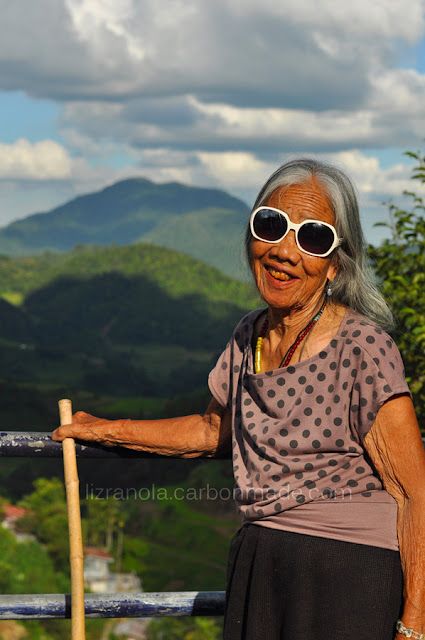Last June 14-16, 2011, we held an art workshop at Banaue, Ifugao. We taught the employees of Civil Service, Northern Luzon chapter, how to create arts and crafts, shoot good photos, how to make installation art, mural painting, perform theater arts, and play indigenous Cordilleran music.
During our free time, we took a couple of side trips. I have been to a few places in Ifugao, and I have loved it. It was my first time to really see Banaue. Banaue is probably the most famous in the province, and when a place is too famous, usually there's too much commercialism going on. It can mean overcrowding and losing the real essence of its culture. Someone I met told me they call Banaue as 'Banaue House Terraces', instead of 'Rice'. I expected that negative side, but our trip turned out to be fun and educational. There were areas of 'House Terraces', but I still stood with awe in the vast forest and rice terraces formation, and met some very interesting locals along the way. Towards the end of our trip, I concluded that it's the people you meet that make your travels unforgettable.
 |
| View from the house of the descendant of Otley Beyer, just right above the Banaue Museum. |
We stayed at the Banaue Hotel, one of the oldest in the place. Their service could still be improved, prices were quite expensive, though they have a good view of the forest and terraces, and you could go down there with the help of their tour guide.
 |
| Mountain view from the Banaue Hotel at sunrise, around 5:30 am, on the right is a reflection of sunrise from the hotel's pool area. |
About five minute tricycle ride from the Banaue Hotel is the Banaue Museum. It is owned by the descendants of Otley Beyer. He is an anthropologist who lived most of his life in the Cordillera region, and got married to the daughter of the chieftain of an Ifugao village. They had a son named William, he had a lot of children, and it was one of his great grandson who greeted us at the entrance. The museum is humble in structure, but rich in Cordilleran artifacts. It houses the prehistoric utensils for hunting and cooking, spears, multi-purpose bags, furniture, jewelries, headdress and other accessories, and photos of the old Ifugao community. Too bad taking of photos were not allowed inside the museum.
Outside, we saw some locals preparing rice after it's been dried under the sun.
 |
| As the day ended, locals sack their bundled rice stalks after drying them out in the sun. |
This is another view from the Banaue Museum, the same place as the first photo of this entry. It's not a pretty sight.
 |
| How much is too much? Though residents cramp at the foot of the mountain, a great portion is still left untouched, a proof that people try to maintain what they call "muyong", or respect to trees. |
 |
| Add caption |
This elder was William Beyer's wife.
 |
| Old and new. This elder was so cool she wears a necklace of ancient Cordlilleran beads and a fashionable sunglasses. |
A block away from the museum, we got curious with this traditional Ifugao house, its wooden surface etched with diagonal patterns and with a carabao's skull skeleton as a centerpiece. The owner noticed us looking at his house, as my co-teacher conversed to him, he said that the view from the street is the back part of the house. My co-teacher said it would be nice to see the front. He was kind enough to let us in :) It turned out that he was the in-law of one of the children of William Beyer, and the house was owned by the Beyers.
 |
| Details of the animal carving were on each end of the beams |
Before the day ended, we went to the highest viewpoints in Banaue. It took us about 20 minutes by tricycle to get here.
 |
| A boy rests on the field |
 |
| Before sunset |
Going home, our attention was caught by the kids playing with their traditional wooden bikes. The older brother showed to our colleague the break pedal of their bike.
 |
| Each of us took turns in posing with the bike, when the younger brother cried at the side. Probably he thought his toy was taken from him. |
The next day before going home, we took a side trip to the bronze smith shop at Matanglag, Banaue.
 |
| Our colleague showing us how the earring is placed |
Our co-teachers purchased some necklaces they've molded on the spot.
Once the design was completely molded, next would be putting details, removing excess bronze, and smoothing it.
 |
| Left: putting eyes on the figure Right: finished product |
 | |
| Left: Smoothing the pendant Right: necklaces with pendants of Ifugao symbols. There are varioius symbols, the one you see here is a good luck charm. |
On the way going back to Baguio, we passed by Lagawe. We wanted to visit the trade fair, and we arrived just in time for lunch. We saw a group of kids in Ifugao outfit having a feast.











(y)
ReplyDelete